Interview with Rob Heinsoo 13th Age Second Edition
Posted on October 26, 2024 by Flames
In this TTRPG developer essay, FlamesRising.com contributor Monica Valentinelli sits down with Rob Heinsoo, the developer of 13th Age Second Edition from Pelgrane Press. The new edition was successfully crowdfunded, and you can pre-order 13th Age Second Edition on Backerkit.
13th Age first debuted in 2013. Now, over ten years later, you’re providing a second edition. What’s your design philosophy for the new edition? How has your approach changed?
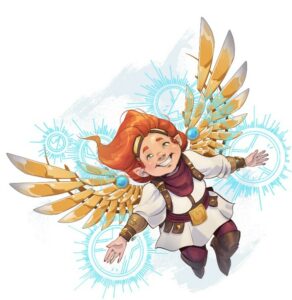 My first thought was that the design philosophy of the new edition is pretty much the same as the first edition, especially because my starting point was to make all books published previously entirely compatible with the new edition. It’s more a matter of living up to the game’s original good intentions!
My first thought was that the design philosophy of the new edition is pretty much the same as the first edition, especially because my starting point was to make all books published previously entirely compatible with the new edition. It’s more a matter of living up to the game’s original good intentions!
After thinking awhile, I realized there are at least three ways our design philosophy has shifted.
First, when we designed the original game, Jonathan and I thought the book was a one-off. We attempted to put everything people would need to play in the 13th Age core book (monsters, treasure, game master advice, characters) because we had no intention of publishing support products. Neither of us wanted to run a roleplaying line, and after WotC’s weird twilight zone neither of us really wanted the game we’d designed to play together to be run by other people.
But the design and publishing process took a long time! By the time the physical book was published, we realized that people wanted support material. And I’d changed my mind and decided to run the game line. In a nod to one of the games that had sparked our imaginations—the Arduin Grimoire and it’s Everything-All-The-Time approach—we’d even taken advantage of a chance to work together again and kickstart the game’s first sequel, 13 True Ways.
This time, we know we’re writing to an audience that has some appetite for other 13th Age books. There’s still a strong incentive to try to fit everything into what has become a two-book core set (Heroes’ Handbook and the Gamemaster’s Guide), especially since Jonathan isn’t planning to work on the 13th Age line, just as he stepped away from it the first go-round. But we know there are other books coming that will provide more 1st level monsters or provide a fully playtested new multiclassing system.
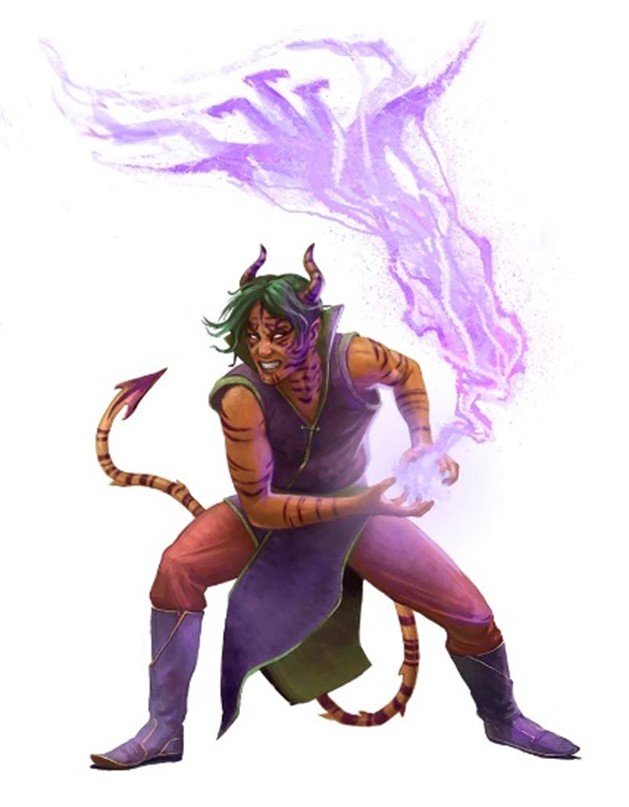 Second, another difference come out in in 2E’s art. In 13th Age 1E we said that there were big variations in how elves, dwarves, humans and other kin looked. But with Aaron McConnell and Lee Moyer as our two creative partners who supplied all the art, the original core book supplied one consistent approach rather than examples of various ways heroes and monsters might look in different campaigns. This time around we’re working with a large number of artists with strikingly different styles. Lee is still pulling things together with lighting and staging, but our diverse artists have created a wonderful mix of people and monsters. The game is set up for every campaign to have its own unique stories, and now the art does a better job of expressing that range of possibilities.
Second, another difference come out in in 2E’s art. In 13th Age 1E we said that there were big variations in how elves, dwarves, humans and other kin looked. But with Aaron McConnell and Lee Moyer as our two creative partners who supplied all the art, the original core book supplied one consistent approach rather than examples of various ways heroes and monsters might look in different campaigns. This time around we’re working with a large number of artists with strikingly different styles. Lee is still pulling things together with lighting and staging, but our diverse artists have created a wonderful mix of people and monsters. The game is set up for every campaign to have its own unique stories, and now the art does a better job of expressing that range of possibilities.
The third shift is also reflected in the art. Every 13th Age character has their own One
Unique Thing, the thing that marks them as a special hero different from everyone else. In 2E, we’ve had fun illustrating some of those unique heroes instead of sticking closely to generic F20 style. Examples? A winged dwarf by Simone Bannach! A tiger-striped tiefling sorcerer by Dagmara Matuszak! These are our characters, and the Kickstarter backers who supported us most generously have added more that we haven’t unveiled yet.
Can you explain what the 13th Age’s setting is like for someone who has never played the game before?
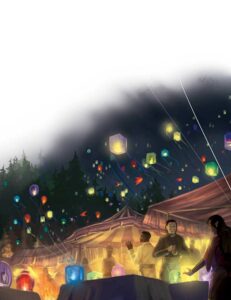 It’s a high-fantasy game and first level characters start as highly competent heroes. That’s not just game mechanics, it’s also the fact that each hero gets to choose one or more relationships with the most powerful NPCs in the game world, the Dragon Empire. The “icons” are archetypal fantasy characters who show up in some incarnation in many fantasy worlds: The Archmage, the Elf Queen, the Emperor, the Lich King, the Prince of Shadows. The world of the Dragon Empire is shaped by the relationships and conflicts between these icons and their followers, and the player characters get a stake in these relationships even at first level.
It’s a high-fantasy game and first level characters start as highly competent heroes. That’s not just game mechanics, it’s also the fact that each hero gets to choose one or more relationships with the most powerful NPCs in the game world, the Dragon Empire. The “icons” are archetypal fantasy characters who show up in some incarnation in many fantasy worlds: The Archmage, the Elf Queen, the Emperor, the Lich King, the Prince of Shadows. The world of the Dragon Empire is shaped by the relationships and conflicts between these icons and their followers, and the player characters get a stake in these relationships even at first level.
The Dragon Empire setting of the game is what we call “half-designed!” Our philosophy is that we game designers aren’t telling the story. Each individual campaign is telling its own story, so our setting and its various bestiaries and adventures and other supplements aren’t creating canon. The core book provides an entertaining paragraph or two on the places on the map, but these locations are presented as open-questions, ideas that specific campaigns can take in different directions. This approach would be kinda lame if we didn’t provide interesting examples that people might want to use! The setting-paragraphs provide fun ideas that are meant to start new stories and create opportunities for surprising twists in individual campaigns. Like, the Festival Scene illustrated by Laura Galli.
What kind of rules are new for second edition?
The icon relationship rules that give players narrative control weren’t executed well in first edition. So the biggest rules change in 2E was to explain the icon connection rules clearly, put them entirely in the players’ hands (until the player rolls a twist while changing the narrative!), and providing around 35 pages of examples detailing all the ways that icon connections can be used. That’s in contrast to the zero pages of examples we included with 1E.
We’ve done a lot of work on the player character powers and spells, because our original impetus for creating a second edition was noticing that there were spells and powers that hardly anyone ever played with. We aim not to waste the reader’s time, every page and paragraph is meant to be interesting somehow, so the 1E powers that were effectively dead-space needed to improve.
For example, I’ve always been frustrated by bards. Our new bard is magical, musical, helpful, and surprising. Each bard hero chooses three of six possible instruments/magical styles to master, gaining songs and leadership abilities and magical powers from each of drums, dance, voice, strings, brass, or flutes.
We also streamlined some of the combat rules, upgraded monsters that were too vanilla to justify their place in a game line, and cleaned up the battle building math so that experienced groups will get more of a challenge. Check out the cover of the Heroes’ Handbook by Aaron McConnell & Lee Moyer.
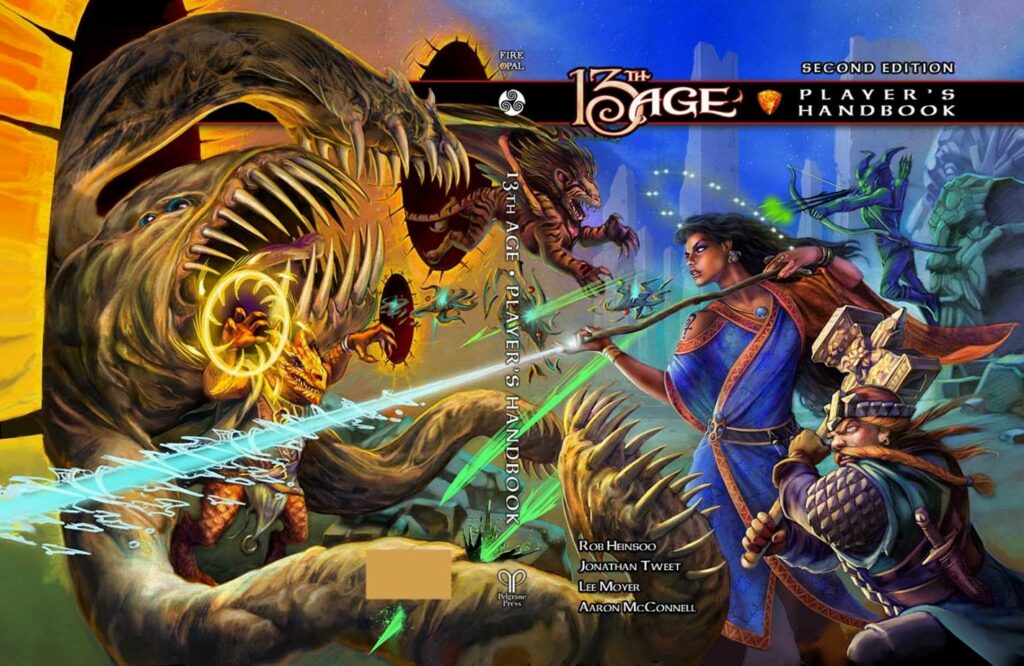
Combat. How does a typical round play out?
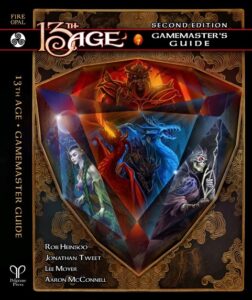 Battles start unfair! The math is deliberately slanted towards the monsters, so when everyone rolls initiative and takes their character’s first turn (everyone gets a standard action, move action, and a quick action) the odds can seem bad. My players love to use this refrain when they see what’s against them in the first round: “This is a bullshit game, you’re a bullshit ref, this is a bullshit system, I hope you’re happy you’ll finally get a TPK.” But it’s not true. At the end of the first round of combat, I put the escalation die on the table, the biggest d6 I own, set to 1. Only the heroes* add the escalation die to their attacks, and it goes up again at the end of each round, so what seems at first to be a hopeless situation almost always resolves into heroes doing heroic things and feeling good about themselves.
Battles start unfair! The math is deliberately slanted towards the monsters, so when everyone rolls initiative and takes their character’s first turn (everyone gets a standard action, move action, and a quick action) the odds can seem bad. My players love to use this refrain when they see what’s against them in the first round: “This is a bullshit game, you’re a bullshit ref, this is a bullshit system, I hope you’re happy you’ll finally get a TPK.” But it’s not true. At the end of the first round of combat, I put the escalation die on the table, the biggest d6 I own, set to 1. Only the heroes* add the escalation die to their attacks, and it goes up again at the end of each round, so what seems at first to be a hopeless situation almost always resolves into heroes doing heroic things and feeling good about themselves.
Overall, combat is a streamlined experience that tries to keep the fun elements of d20-rolling fights and skip the boring stuff. No one has to count squares. You’re either engaged with an enemy, near them (one move away), or far away (probably able to reach them in two moves). The combat is crunchy enough for those of who like crunch, but storytelling touches and unpredictable monster mechanics keep things interesting for the GM as well as the players. (Gamemasters’ Guide cover by Aaron McConnell & Lee Moyer.)
*Dragons also use the escalation die!
Tea or coffee?
Until a couple years ago, I would have said coffee. But I’m now more often caffeinated by yerba mate. I’m drinking from cans and tea bags, not the traditional Uruguayan gourd.
What’s next for you?
For something of a change, I do know what’s next!
I’m working on finishing art direction for the two 13th Age 2E core books and making changes suggested by playtest feedback. That’s going to take me through 2024. Some time early in 2024 I’ve got an Armello boardgame expansion to design to follow up on that board game’s Kickstarter success; it’s a deckbuilding quest game of anthropomorphic animals fighting each other to replace their corrupt King!
There’s another card game I’ve been tinkering with in off hours, but I may not get to that until later.
First, there are several 13th Age supplements I need to help finish including one called Bestiary 3: Icon Followers that I need to finish writing myself. After the Bestiary, I’ll start serious work on a book of new 13th Age classes that I call Further Adventurers. Not all the classes in it will match the way the core classes are constructed. Some of the new classes will be micro-classes, with just enough content for a memorable one campaign experience, not intended to create a range of possible characters like the barbarian, cleric, or wizard.
Tags | 13th age, pelgrane press, TTRPG, ttrpgs

